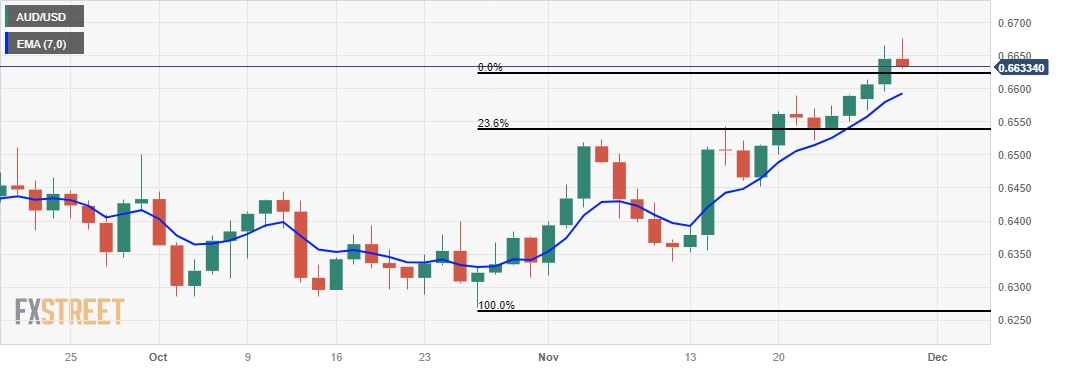- Australian Dollar snaps a winning streak amid downbeat Aussie monthly CPI.
- Australia’s Monthly Consumer Price Index declined by 4.9% in October against the expected 5.2%.
- US Dollar Index loses ground despite the better-than-expected US economic data.
The Australian Dollar (AUD) snaps a four-day winning streak day post trimming intraday gains during the early European session on Wednesday. However, the AUD/USD pair surged on a heightened risk appetite in the market and the upward movement in commodity prices. Additionally, the softer US Dollar (USD), influenced by a less hawkish stance from the US Federal Reserve (Fed), is providing support to the AUD/USD pair.
Australia's Monthly Consumer Price Index (CPI) for October shows a reading of 4.9%, a decrease from the previous reading of 5.6% in September and slightly below the expected 5.2%. While the downbeat data have initially exerted some pressure, it seems that the Australian Dollar (AUD) has managed to recover from that pressure.
The US Dollar Index (DXY) has dipped to its lowest level since August 11 despite the better-than-expected Housing Price Index and Consumer Confidence data from the United States (US). The decline in US Treasury yields acted as an additional negative factor for the Greenback.
Fed Governor Christopher Waller’s comments, suggesting that if inflation consistently declines, there's no need to insist on maintaining high interest rates, further fueled the negative momentum for the Greenback.
Investors are expected to shift their focus to the preliminary Gross Domestic Product Annualized (GDP) data for the third quarter in the US. This key economic indicator will provide insights into the pace and trajectory of economic growth during that period. Later in the day, the Federal Reserve will release the Beige Book, providing a comprehensive picture of the overall economic growth in the United States (US).
Daily Digest Market Movers: Australian Dollar received upward support on softer US Dollar
- Australia’s seasonally adjusted Retail Sales data showed monthly readings for October, which declined by 0.2% against the market expectations of a 0.1% rise and 0.9% prior.
- Reserve Bank of Australia (RBA) Governor Michele Bullock highlighted that the current monetary policy is on the restrictive side, with rate hikes putting a damper on demand, particularly in the context of persistent services inflation.
- Governor Bullock emphasized the need for caution in employing high interest rates to combat inflation without inadvertently raising the unemployment rate.
- The People's Bank of China (PBoC) has issued a notice to strengthen financial support for private firms. This comprehensive support encompasses assistance for private enterprises in listing and financing, mergers and acquisitions, as well as restructuring.
- Federal Open Market Committee (FOMC) meeting minutes revealed that members decided unanimously to keep policy restrictive for some time until there is clear and sustainable evidence of inflation moving down toward the Committee's target.
- US Housing Price Index (MoM) remained consistent at 0.6% in September against the expected figure of 0.4%.
- The CB Consumer Confidence Index experienced an increase in November, rising to 102.0. This uptick comes after a downward revision of October figures, which were adjusted from 102.6 to 99.1.
Technical Analysis: Australian Dollar moves below 0.6650 major level
The Australian Dollar trades around the 0.6630 psychological level on Wednesday. The next resistance lies at the major level of 0.6650, following the next significant barrier at the psychological level of 0.6700. A breakthrough above this level could potentially support the AUD/USD pair, allowing it to test the region around August's high at 0.6723. On the downside, the key support is positioned around the seven-day Exponential Moving Average (EMA) at 0.6592. A decisive break below the EMA could potentially push the pair to reach the support near the 23.6% Fibonacci retracement level at 0.6569.
AUD/USD: Daily Chart
Australian Dollar price today
The table below shows the percentage change of Australian Dollar (AUD) against listed major currencies today. Australian Dollar was the weakest against the New Zealand Dollar.
| USD | EUR | GBP | CAD | AUD | JPY | NZD | CHF | |
| USD | 0.14% | 0.06% | -0.08% | 0.33% | 0.10% | -0.53% | 0.02% | |
| EUR | -0.14% | -0.06% | -0.22% | 0.19% | -0.04% | -0.68% | -0.13% | |
| GBP | -0.08% | 0.05% | -0.15% | 0.24% | 0.02% | -0.64% | -0.05% | |
| CAD | 0.08% | 0.22% | 0.15% | 0.41% | 0.17% | -0.45% | 0.09% | |
| AUD | -0.33% | -0.21% | -0.26% | -0.43% | -0.24% | -0.87% | -0.31% | |
| JPY | -0.11% | 0.04% | -0.03% | -0.19% | 0.24% | -0.62% | -0.08% | |
| NZD | 0.56% | 0.65% | 0.60% | 0.45% | 0.86% | 0.62% | 0.54% | |
| CHF | -0.02% | 0.12% | 0.06% | -0.07% | 0.32% | 0.08% | -0.54% |
The heat map shows percentage changes of major currencies against each other. The base currency is picked from the left column, while the quote currency is picked from the top row. For example, if you pick the Euro from the left column and move along the horizontal line to the Japanese Yen, the percentage change displayed in the box will represent EUR (base)/JPY (quote).
Australian Dollar FAQs
What key factors drive the Australian Dollar?
One of the most significant factors for the Australian Dollar (AUD) is the level of interest rates set by the Reserve Bank of Australia (RBA). Because Australia is a resource-rich country another key driver is the price of its biggest export, Iron Ore. The health of the Chinese economy, its largest trading partner, is a factor, as well as inflation in Australia, its growth rate and Trade Balance. Market sentiment – whether investors are taking on more risky assets (risk-on) or seeking safe-havens (risk-off) – is also a factor, with risk-on positive for AUD.
How do the decisions of the Reserve Bank of Australia impact the Australian Dollar?
The Reserve Bank of Australia (RBA) influences the Australian Dollar (AUD) by setting the level of interest rates that Australian banks can lend to each other. This influences the level of interest rates in the economy as a whole. The main goal of the RBA is to maintain a stable inflation rate of 2-3% by adjusting interest rates up or down. Relatively high interest rates compared to other major central banks support the AUD, and the opposite for relatively low. The RBA can also use quantitative easing and tightening to influence credit conditions, with the former AUD-negative and the latter AUD-positive.
How does the health of the Chinese Economy impact the Australian Dollar?
China is Australia’s largest trading partner so the health of the Chinese economy is a major influence on the value of the Australian Dollar (AUD). When the Chinese economy is doing well it purchases more raw materials, goods and services from Australia, lifting demand for the AUD, and pushing up its value. The opposite is the case when the Chinese economy is not growing as fast as expected. Positive or negative surprises in Chinese growth data, therefore, often have a direct impact on the Australian Dollar and its pairs.
How does the price of Iron Ore impact the Australian Dollar?
Iron Ore is Australia’s largest export, accounting for $118 billion a year according to data from 2021, with China as its primary destination. The price of Iron Ore, therefore, can be a driver of the Australian Dollar. Generally, if the price of Iron Ore rises, AUD also goes up, as aggregate demand for the currency increases. The opposite is the case if the price of Iron Ore falls. Higher Iron Ore prices also tend to result in a greater likelihood of a positive Trade Balance for Australia, which is also positive of the AUD.
How does the Trade Balance impact the Australian Dollar?
The Trade Balance, which is the difference between what a country earns from its exports versus what it pays for its imports, is another factor that can influence the value of the Australian Dollar. If Australia produces highly sought after exports, then its currency will gain in value purely from the surplus demand created from foreign buyers seeking to purchase its exports versus what it spends to purchase imports. Therefore, a positive net Trade Balance strengthens the AUD, with the opposite effect if the Trade Balance is negative.
Information on these pages contains forward-looking statements that involve risks and uncertainties. Markets and instruments profiled on this page are for informational purposes only and should not in any way come across as a recommendation to buy or sell in these assets. You should do your own thorough research before making any investment decisions. FXStreet does not in any way guarantee that this information is free from mistakes, errors, or material misstatements. It also does not guarantee that this information is of a timely nature. Investing in Open Markets involves a great deal of risk, including the loss of all or a portion of your investment, as well as emotional distress. All risks, losses and costs associated with investing, including total loss of principal, are your responsibility. The views and opinions expressed in this article are those of the authors and do not necessarily reflect the official policy or position of FXStreet nor its advertisers. The author will not be held responsible for information that is found at the end of links posted on this page.
If not otherwise explicitly mentioned in the body of the article, at the time of writing, the author has no position in any stock mentioned in this article and no business relationship with any company mentioned. The author has not received compensation for writing this article, other than from FXStreet.
FXStreet and the author do not provide personalized recommendations. The author makes no representations as to the accuracy, completeness, or suitability of this information. FXStreet and the author will not be liable for any errors, omissions or any losses, injuries or damages arising from this information and its display or use. Errors and omissions excepted.
The author and FXStreet are not registered investment advisors and nothing in this article is intended to be investment advice.
Recommended content
Editors’ Picks

EUR/USD soars past 1.1200 as China's tariffs confirmed at 145%
EUR/USD soared beyond 1.1200 amid headlines confirming the latest round of tariffs, levies on Chinese imports reached 145%. Wall Street collapses amid renewed concerns that Trump's policies will hit the American economy. Soft US inflation data released earlier in the day adds to the broad US Dollar's weakness.

GBP/USD closes in to 1.3000 on renewed USD selling
GBP/USD resumed its advance and nears the 1.3000 mark, as speculative interest resumed US Dollar selling. Softer than anticipated US CPI figures and persistent tensions between Washington and Beijing over trade weigh on the American currency and Wall Street.

Gold resumes record rally, reaches $3,175
Gold extended its record rally on fresh tariff-related headlines, trading as high as $3,175 a troy ounce in the American session. The White House confirmed 35% levies on Mexico and Canada, 145% on Chinese imports, resulting in a fresh round of USD selling and pushing XAU/USD further up.

Cardano stabilizes near $0.62 after Trump’s 90-day tariff pause-led surge
Cardano stabilizes around $0.62 on Thursday after a sharp recovery the previous day, triggered by US Donald Trump’s decision to pause tariffs for 90 days except for China and other countries that had retaliated against the reciprocal tariffs announced on April 2.

Trump’s tariff pause sparks rally – What comes next?
Markets staged a dramatic reversal Wednesday, led by a 12% surge in the Nasdaq and strong gains across major indices, following President Trump’s unexpected decision to pause tariff escalation for non-retaliating trade partners.

The Best brokers to trade EUR/USD
SPONSORED Discover the top brokers for trading EUR/USD in 2025. Our list features brokers with competitive spreads, fast execution, and powerful platforms. Whether you're a beginner or an expert, find the right partner to navigate the dynamic Forex market.




